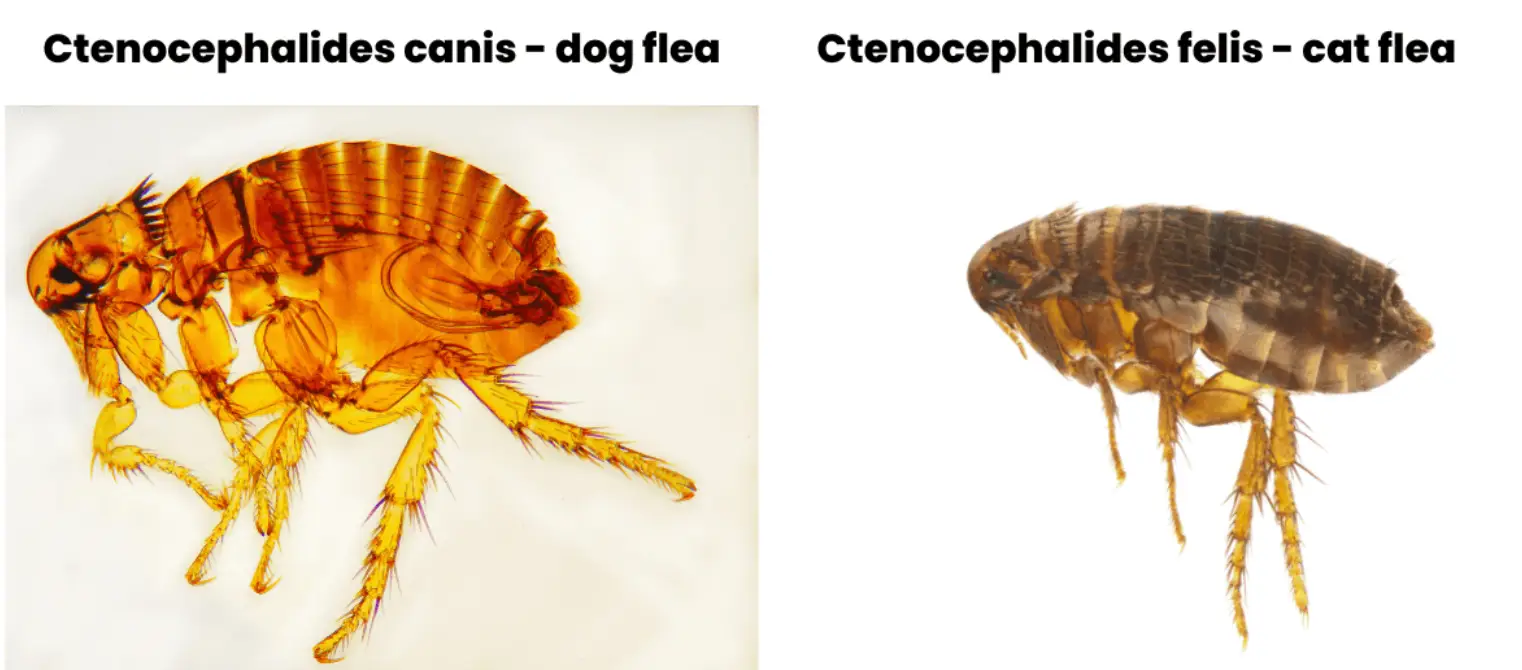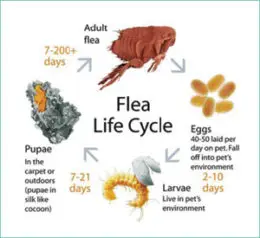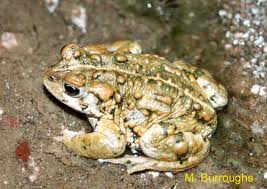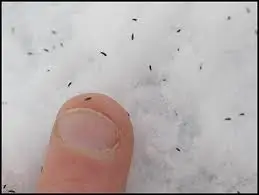Last Updated on 05/01/2025 by Kimberly
Are cat and dog fleas different? Yes, there is a difference between cat – dog fleas. Although they both can be found on either cats or dogs they prefer their specific host.
While many might think that a flea is just a flea, it turns out there are differences between the types that infest cats and dogs. Understanding these differences is key to effective treatment and prevention, ensuring the health and comfort of our furry friends and ourselves.

Fleas are more than just a nuisance; they’re tiny parasites that can cause big problems for both pets and humans. These wingless insects feed on the blood of their hosts, leading to discomfort, itching, and sometimes serious health issues.
Fleas can quickly become a major infestation if not addressed properly. They reproduce at an alarming rate, with a single flea laying up to 50 eggs a day. These eggs can fall off your pet and into carpets, bedding, or furniture, leading to a widespread problem within your home.
Knowing whether you’re dealing with cat fleas or dog fleas can help tailor the appropriate treatment and preventative measures. Misidentification can lead to ineffective treatments and prolonged discomfort for pets and owners alike.
Taking the time to learn about these pests, their life cycles, and how they affect different hosts can empower pet owners to take proactive steps in keeping both their pets and homes flea-free.
What are Cat Fleas?
Cat fleas, scientifically known as Ctenocephalides felis, are the most common type of flea found on domestic cats and dogs worldwide. Despite their name, cat fleas can infest a variety of animals, including dogs, rabbits, and even wild mammals. Their adaptability and prevalence make them a significant concern.
These pests go through a complete metamorphosis, meaning they have four life stages: egg, larva, pupa, and adult. The entire lifecycle can be completed in as little as two weeks under ideal conditions, which include warmth and humidity. Knowing this helps in planning effective treatments, as breaking the flea lifecycle is crucial to eradicating an infestation.
Cat fleas thrive in warm, humid environments. They lay eggs on their host, but the eggs often fall off and hatch in the surrounding environment. That’s why treating both the pet and its living spaces is essential. Regular cleaning of bedding, carpets, and furniture can minimize the risk of re-infestation.
When it comes to identifying cat fleas, they are small, wingless, and reddish-brown, usually about 1-3 mm in length. Their bodies are laterally compressed, which helps them move through their host’s fur. The adult fleas are bloodthirsty, feeding several times a day, which can cause severe discomfort and lead to allergic reactions or skin infections in pets.
Treating cat fleas typically involves a combination of topical treatments, oral medications, and environmental control. Veterinary guidance is invaluable for choosing the most effective products and strategies. Timely intervention and consistent preventive measures can keep your pets and home flea-free.
What are Dog Fleas?
Dog fleas, scientifically called Ctenocephalides canis, are less common than cat fleas but still cause plenty of problems for our canine companions. Though they prefer dogs, these fleas can also be found on cats, wild animals, and even humans under certain conditions.
Dog fleas share the same four-stage life cycle as cat fleas: egg, larva, pupa, and adult. The entire process can span anywhere from a few weeks to several months, depending on environmental factors like temperature and humidity. Understanding this lifecycle is essential for effective flea control, as treatments must target multiple stages to be successful.
Unlike cat fleas, dog fleas aren’t as widespread but can still establish themselves quickly in the right conditions. They tend to thrive in shaded outdoor areas and can easily latch onto dogs during walks or outdoor play. Once on the host, they feed on blood, leading to itching, skin irritation, and sometimes more severe health issues like flea allergy dermatitis.

Spotting dog fleas on your pet involves looking for the same reddish-brown, wingless insects that you’d find with cat fleas. They’re about 1-4 mm long and can be seen moving through the fur. However, the presence of “flea dirt” (tiny black specks of flea feces) on your pet’s skin is also a strong indicator.
Treating a dog flea infestation involves a mix of approaches similar to those used for cat fleas: topical treatments, oral medications, and environmental control. Regular grooming and vacuuming can help, but consulting your vet for the most effective treatment plan is always a good idea. This comprehensive approach ensures that every stage of the flea’s life cycle is addressed, bringing relief to your furry friend.
Cat – Dog Fleas Can They Be Shared Between Each Other?
Yes, cats and dogs can indeed share fleas. While cat fleas (Ctenocephalides felis) are more common and can infest both cats and dogs, dog fleas (Ctenocephalides canis) tend to stick primarily to dogs but can also make the jump to other pets if the conditions are right.
Cross-species flea infestations happen when pets share common spaces or interact closely. For example, a dog and a cat living in the same household or sharing the same outdoor environment are highly likely to pass fleas between each other. This cross-infestation is why it’s vital to treat all household pets simultaneously when dealing with flea issues.
The environment plays a crucial role in flea transmission. Fleas lay eggs that fall into the pet’s surroundings, which then hatch and eventually latch onto any suitable host passing by. Therefore, even if one pet is initially infested, fleas can easily find their way onto other pets in the home. To prevent this, vigilant cleaning and regular use of flea preventatives are necessary for all pets.
It’s also important to remember that fleas can jump quite long distances relative to their size. This ability allows them to transfer between pets even if they aren’t in constant contact. Flea eggs and larvae can also be present in bedding, carpets, and other areas where pets sleep or spend time, making comprehensive household treatment a must.
To manage and prevent cross-species infestations, maintaining a regular regimen of flea preventatives, engaging in routine grooming, and keeping the living environment clean are essential. Consulting with a veterinarian for the best flea control products and strategies can ensure all pets remain flea-free.
Impact of Cat – Dog Fleas on Humans
Both cat fleas and dog fleas are known to bite humans. While fleas prefer animal hosts, they will not hesitate to feed on human blood if given the opportunity. This can result in itchy, uncomfortable bites, often found around the ankles and lower legs.
Flea bites on humans can cause more than just itching. Some people experience allergic reactions, leading to more severe irritation, swelling, or even secondary infections from scratching. In some cases, fleas can also transmit diseases such as murine typhus or, less commonly, tapeworms if accidentally ingested.
Preventing flea bites on humans starts with controlling the flea population on pets and within the home. Use veterinarian-recommended flea prevention treatments on all pets, regularly wash pet bedding, and vacuum frequently to remove any flea eggs or larvae from carpets and furniture.
If you do get bitten, it’s important to treat the bites promptly. Clean the area with soap and water to reduce the risk of infection, and consider using over-the-counter anti-itch creams to alleviate discomfort. In cases of severe allergic reactions or if the bites become infected, seeking medical advice is recommended.
Maintaining a flea-free environment requires vigilance and a proactive approach. Regularly treating pets, keeping living areas clean, and monitoring for signs of fleas can significantly reduce the risk of flea bites for both pets and humans. Ensuring the well-being of all household members, furry or otherwise, means staying ahead of these pesky parasites.
In Conclusion To The Difference Between Cat – Dog Fleas
I hope you found the information that you were looking for so that you can distinguish between cat and dog fleas. Due to the size of the flea, it’s very hard to tell what flea is actually in your home and on your pets. Rest assured that flea medications and flea killers for your pets, home and yard will do the job for both species of fleas.
If you have any questions or if you would like to share any experiences that you have had with either flea species, please leave it below in the comments section. Sharing our own flea journeys and treatments is a great way to help everyone get rid of the pests and is greatly appreciated.
Thank you for visiting Fleas B Gone, have a great day. 🙂








